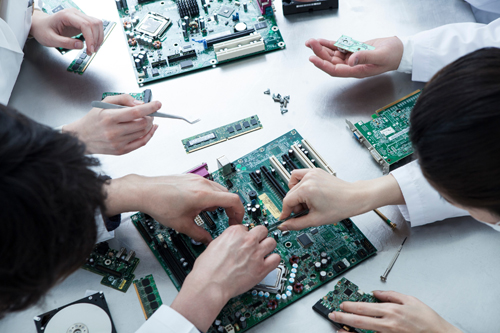Printed Circuit Board (PCB) is an essential component of electronic devices. It connects different electronic components and provides a pathway for the flow of electricity. PCBs are made up of different materials that determine their performance, durability, and cost. Choosing the right PCB material is crucial for the success of any project. In this essay, we will discuss the various PCB material options and help you choose the right one for your project.

1. FR-4:
FR-4 is the most commonly used PCB material. It is a glass-reinforced epoxy laminate that provides excellent electrical insulation and mechanical strength. FR-4 has a low dielectric constant, which makes it suitable for high-frequency applications. It is also resistant to heat and flame, making it ideal for applications that require high-temperature resistance. FR-4 is a cost-effective option that offers good performance and durability.
2. Metal Core:
Metal Core PCBs are made up of a metal core layer sandwiched between two layers of copper. The metal core provides excellent heat dissipation, making it suitable for applications that generate a lot of heat, such as LED lighting and power electronics. Metal Core PCBs are also more rigid than FR-4 PCBs, making them suitable for applications that require high mechanical strength.
3. Ceramic:
Ceramic PCBs are made up of a ceramic substrate coated with a thin layer of conductive material. Ceramic offers excellent thermal conductivity, making it ideal for high-power applications that generate a lot of heat. Ceramic PCBs are also highly resistant to corrosion and chemical damage, making them suitable for harsh environments.
4. Flex:
Flex PCBs are made up of flexible plastic substrates that can be bent or twisted without breaking. Flex PCBs offer excellent space-saving capabilities, making them ideal for compact devices such as smartphones and wearables. Flex PCBs are also lightweight and offer good resistance to vibration and shock.
5. Rogers:
Rogers PCBs are made up of a ceramic-filled hydrocarbon substrate that provides excellent electrical performance and thermal stability. Rogers PCBs are suitable for high-frequency applications and offer low signal loss and high dielectric constant. Rogers PCBs are also highly resistant to moisture and offer good dimensional stability.
In conclusion, choosing the right PCB material is crucial for the success of any project. Each material has its own advantages and disadvantages, and the choice depends on the specific requirements of the project. FR-4 is a cost-effective option that offers good performance and durability. Metal Core PCBs provide excellent heat dissipation and mechanical strength. Ceramic PCBs offer excellent thermal conductivity and resistance to harsh environments. Flex PCBs offer excellent space-saving capabilities, while Rogers PCBs provide excellent electrical performance and thermal stability.
Optima Technology is a global provider of PCBs, PCB Assemblies, Cables and System Assemblies located in Lewisberry, PA and New Delhi, India. Since 1995, Optima has specialized in providing local support coupled with cost-effective pricing via offshore manufacturing through our ISO approved facilities. Please reach out to optima@optimatech.net if you’d like to discuss further your PCB or Electronic Assembly needs.